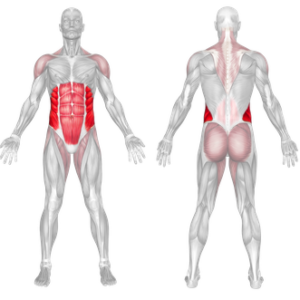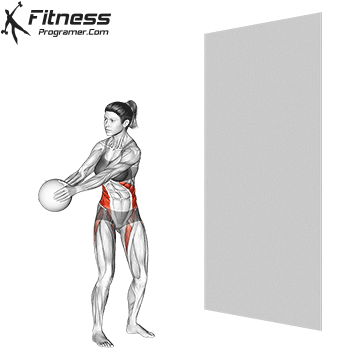Overview Of Medicine Ball Rotational Throw
The medicine ball rotational throw is a dynamic exercise that involves explosively rotating your torso while throwing a medicine ball. It targets the core, obliques, hips and upper back. It is commonly used in strength and conditioning programs for athletes in sports that require rotational power, such as baseball, golf, and tennis.
By incorporating the medicine ball rotational throw into your workout routine, you can improve core strength, rotational power, and stability, which are beneficial for various sports and daily activities.
How to do:
Here’s a comprehensive guide to help you improve your skills and efficiency in performing this exercise.
- Starting Position: Stand about two to four feet away from the wall, facing it, with a medicine ball held in both hands. Medicine ball (choose an appropriate weight based on your fitness level and goals).
- Movement Preparation: Take the medicine ball to your back hip. This initial movement involves a rotation of the torso as you load the ball onto your back hip, preparing for the explosive throw.
- Weight Transfer: Transfer your weight from the back hip to the front hip. This dynamic weight shift is a crucial component of generating power in the throw.
- Hip Rotation: Rotate your hips explosively as you throw the ball against the wall. The explosive hip rotation is a key element for generating power in this exercise. Emphasize the power generated from the hips, not just the arms.
- Catch and Repeat: After the ball rebounds off the wall, catch it with both hands. Take a moment to rest and then repeat the movement.
Master the Medicine Ball Rotational Throw
Mastering the medicine ball rotational throw requires a combination of proper technique, strength, power, and coordination. Understand the mechanics of the exercise, including the starting position, rotational movement, and throwing technique. Practice without the ball initially to focus on proper body mechanics and movement patterns. Gradually increase the weight of the medicine ball as you become more proficient with the exercise.
Tips:
- Engage your core throughout the movement to stabilize your spine.
- Emphasize the transfer of weight from the back hip to the front hip during the movement.
- Engage your core and focus on generating power through hip rotation.
- Keep a slight bend in your knees and maintain good posture.
- The arms serve as an extension of the hip rotation, so avoid relying solely on arm strength.
- Maintain a controlled and fluid motion, avoiding excessive tension in the neck and shoulders.
- Perform the exercise in a controlled manner, emphasizing both the throw and the catch.
By following these guidelines and focusing on consistent practice and improvement, you can master the medicine ball rotational throw and reap its benefits for core strength, power, and athletic performance.
Benefits of Med-Ball Rotational Throw
1- Core Strength: Engages the muscles of the core, including the rectus abdominis, obliques, and transverse abdominis. Improves core stability and strength, essential for overall functional fitness.
2- Hip Power Development: Emphasizes explosive hip rotation, helping to develop power in the hip muscles. Strengthens the glutes and hip abductors, contributing to improved athletic performance.
3- Enhanced Coordination: Requires coordinated movement between the upper and lower body. Improves overall coordination, which is beneficial for various physical activities and sports.
4- Sports-Specific Training: Mimics the rotational movements seen in sports such as golf, tennis, baseball, and others. Provides sport-specific training for athletes involved in activities requiring rotational power.
5- Full-Body Workout: Involves multiple muscle groups, including the core, hips, upper back, and shoulders. Offers a comprehensive and efficient full-body workout in a single exercise.
6- Explosive Power: Focuses on explosive movements, aiding in the development of power and speed. Suitable for athletes looking to enhance their ability to generate force quickly.
7- Caloric Expenditure and Conditioning: Can be incorporated into high-intensity interval training (HIIT) for cardiovascular benefits. Supports fat loss and conditioning when performed with higher repetitions and intensity.
8- Improved Posture: Encourages proper body mechanics and posture during rotational movements. Reinforces good spinal alignment and body awareness.
9- Versatility: Adaptable to different fitness levels by adjusting the weight of the medicine ball and the intensity of the throws. Can be performed with various rep ranges to target different fitness goals.
10- Functional Movement: Enhances the ability to perform everyday activities involving rotational movements. Improves overall functional fitness, translating into better performance in daily life.
Muscles Worked
The medicine ball rotational throw primarily targets the muscles involved in rotational movements, as well as those responsible for stabilizing the core and generating power. Here are the main muscles worked during the medicine ball rotational throw:

- Rectus Abdominis: This is the muscle responsible for flexing the spine and is engaged during the rotation and throwing phases of the exercise.
- Obliques: Both the internal and external obliques are heavily engaged during the rotational movement, as they are responsible for rotating the torso and providing stability.
- Transverse Abdominis: This deep abdominal muscle helps stabilize the core and pelvis, providing support during rotational movements.
- Anterior Deltoid: The front shoulder muscles are activated during the throwing phase to help propel the medicine ball forward.
- Trapezius: The trapezius muscles in the upper back are engaged to stabilize the shoulder girdle and assist in transferring force from the core to the arms.
- Gluteus Medius: This muscle on the side of the hip helps stabilize the pelvis during the rotational movement.
- Erector Spinae: The muscles along the spine are engaged to maintain proper spinal alignment and support during the rotational movement.
- Tensor Fasciae Latae: This muscle located on the side of the hip assists in hip abduction and stabilization during the rotation.
- Multifidus: These small muscles along the spine help stabilize and support the vertebrae during movement.
- Triceps: The triceps muscles are engaged during the throwing phase to extend the arms and propel the medicine ball forward.
While these are the primary muscles worked during the medicine ball rotational throw, other stabilizing muscles throughout the body may also be engaged to a lesser extent to support proper form and execution of the exercise.

